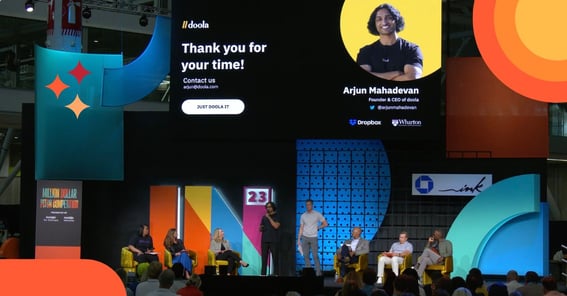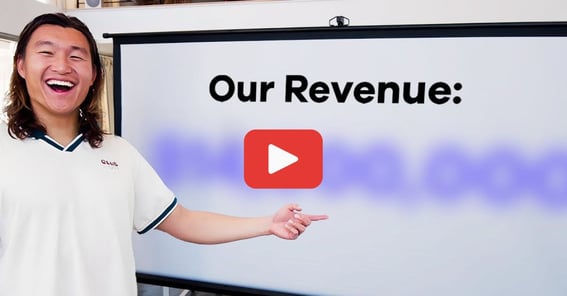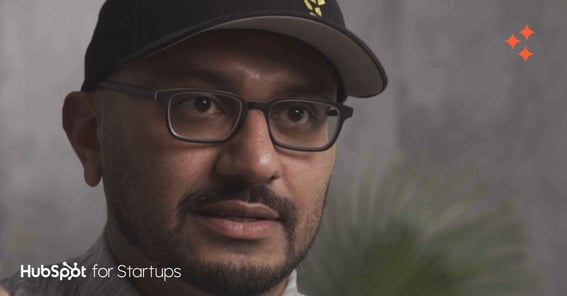Introduction
For startups, moving from the seed stage, where the company has generated some interest and enough funding (from their own savings or through friends and family) to get started, to series funding, where startups pitch to venture capital firms and investors, can be challenging.
In fact, according to Crunchbase, only about one in three startups go from seed to series funding. Many hurdles can prevent startups from reaching the next stage of growth, whether through a lackluster business plan, a poorly designed pitch deck, or even just a struggle to meet potential investors.
One way for startups to prepare for these challenges is to learn from those who have already been through the process … and succeeded.
A conversation with Arjun Mahadevan
Arjun Mahadevan, CEO of doola and host of the 15 Minute Founder podcast, knows a thing or two about the fundraising and scaling process for startups.
The company, which offers entrepreneurs easy-to-access tools (for tasks like state filing, incorporating, banking, and compliance) to start a business, raised $8M in its Series A funding. It recently raised additional funding in a strategic investment round, and the company has raised $13M to date since its inception in 2020.
Mahadevan and doula were also one of the two winners of HubSpot for Startup’s “Million Dollar Pitch Competition” last year, receiving an $1M investment.

Mahadevan spoke with HubSpot for Startups on fundraising for startups, including tips for connecting with investors and maintaining relationships, the unexpected trials and tribulations of raising capital, and exciting advancements in the startup founders’ journey.
HSFS: What are some of the most unexpected parts of raising capital?
Arjun Mahadevan: An investor, when you talk to them, they might be saying everything that implies they're very excited. And then they ultimately will pass. And then you're like, “Well, what happened? All the signs look like it was a go, go, go.”
Upon reflection, what I’ve realized is that it’s actually their job to get as much information as possible to evaluate. But something I've learned the hard way is it's never official until a term sheet or a safe is signed, and until money is wired. So, up until then, you have to temper your expectations.
It's the same way how, in sales, when you're talking to a customer, you're also going to pitch and present the best version of yourself, and you want to keep the door open, you never want to close the door. So I think that's the first thing: that it's never official until it’s signed on the dotted line or money is sent.
The second thing, and this is something I’m trying to improve, is that, I don't think anyone's born a good fundraiser. So you are always just improving. And I'm also realizing that the more tracking you can do, the more efficient you'll be and the better system you'll have. You might read these stories of people tweeting and then closing a full round in 16 hours. Maybe that has happened. But that's the outlier. It's 0.0001%. Most fundraisers are a grind, they take several months. If you have a system, or a funnel, or a process, the volume is actually what's going to lead to the results, not only from the repetitions, but if you keep track of, “Hey, I'm talking to all of these investors,” and then you learn from experience.
I've heard from other investors that it takes 30, sometimes even 60 tries, then you realize, “Wait, I've only done these 10 calls, I'm not even in the position to get a yes.” You turn rejection into actually part of the process instead.
HSFS: How does a startup meet and make meaningful connections with investors?
AM: I've actually met investors from sending them a Twitter DM, to investors who met us after demo day through Y Combinator, to other investors who we actually got introduced to from existing investors. I think it’s actually a mix of everything: warm outbound or warm intros could outbound, inbound, and then intros, like the full spectrum of potential introductions. I think you should take advantage of all of them, right? There's no point in cutting off one of those potential vectors.
At the end of the day, I'd say the commonality between all of those investors, especially at the earliest stages, ultimately, they're making a bet on you and the team when you start. So the biggest thing there is that you're actually selling them on yourself, and why you and your team are actually the best to go after this idea. Because anyone could tactically work on something, why do they think you are the best to do that?
The second thing I've noticed, in hindsight, is that it can take time, but typically, when someone is genuinely interested, they will move faster.
That's a bit tough, though, because there have been cases when we've had investors, and we've known them for over a year. It's like when we first met, then the timing wasn't right, stayed in touch, but then when it is time to go, things do move quickly.
This is something which I'm trying to do a much better job of, is actually keep track of how many investors am I talking to each week. Am I meeting one new investor? Great, because if I do that once a week in a year, that's 52 new investors I've met, versus now you might not know a single one. So that's the way I'm trying to systemize things there.
But ultimately, listen to your customers. If customers are paying you, and customers are excited, there's something there. Then, to reframe, it's more about, okay, I'm actually not doing a good job of telling the story or translating the limited data we have to what we can do next.
So that's more of an extreme ownership approach of, if someone doesn't get it, what can I do better? Then understand, you don't need to convince everyone, all you need is a market of one. You just need one person to say yes, that's actually it. Understanding that “no’s” are part of the process. If I talk to 100 people, I have a much better shot than if I just talked to 10. But if I talk to 100 people, and I'm getting the same feedback every time, then let's not be delusional, let's actually listen to what people are saying and look at the customers and the data too.
HSFS: How can founders who may not feel naturally outgoing maintain connections or put themselves out there with investors?
AM: I actually think that being cringe is a requisite for success in anything, especially in business, you have to be cringe or shameless. I also heard recently that success in life is directly correlated to the number of uncomfortable conversations you're willing to have or things you're willing to do, meaning it's actually going to be uncomfortable. It's never natural.
It’s actually a good proxy that if you feel uncomfortable, it’s toward something positive.
I like to think, okay, there's a chance, of course, this can fail. The odds of failure never go to zero, but they can get de-risked over time. Then what I have to say is, if this were to fail, I would regret having not left it all on the table. So sometimes, in the moment when I'm like, “This feels weird,” if I put myself in the future state, I realize I have to do this thing. Because it would just eat at me if I was like, “Why didn't I try posting on this channel? Why didn't we try this strategy?” It's more of regret minimization, which helps me in the moment to do the uncomfortable thing.
You don't get less scared, you get more brave, but you still get the butterflies, you still get scared about doing the thing.
To give a more practical example, what I think the hardest thing is when you start in anything new, be it outbound sales, or content, or a new hobby, you don't see results for a certain period of time. Let's say, posting on LinkedIn, or social, you’re posting but you're not getting likes or comments, which really don't mean much. What you want is customers, but still, that's an early sign, you're not getting those. If anything, you're getting people who are critiquing you, or saying that's cringe. And oftentimes, what happens is you give up or stop during that period, because you don't have the feedback, but at a certain point by outlasting others, because only 1% of people post on any platform, 99% post nothing, at a certain point, you start to get feedback.
I think overall, content isn't just a way to acquire customers, although I think that's the ultimate goal, but it helps hiring and talent. And it helps with staying top of mind with investors, too. I think what I realized is that from that perspective, I know that if doola doesn't reach the level I think it can reach, I will regret having not tried these things. So that's one thing we're like, “Okay, we’ve got to do the thing, even if it's uncomfortable,” and it helps in multiple ways. I knew that the absence of it wouldn't help. It doesn't mean I spent all my time on it, but I know there's value from doing it. So it's balancing that with everything else that we have to do.
HSFS: At what point did you realize you were ready to be in a startup founders’ community, such as Y Combinator or On Deck?
AM: I think everyone wants to be a part of some community, we all want belonging. It's widely wired in our DNA, and we want to be with other people, whether it's the family unit or friends or community. Very candidly, I hadn't done this before. Take all the help you can get.
YC, I think, really helps you peek around the corners that you didn't know existed, which is fantastic. On Deck, too, when I had the itch to start something, I thought, “I get to do this with other people who are also ideating, and in that same stage, fantastic, I can learn and meet people doing that, too.”
I think part of it also is with On Deck or other communities, it might feel a bit uncomfortable to put yourself out there with something that's so new. But what I like about it is that you're surrounding yourself with other people in that same spot. I think that's the thing with any idea, it's so fragile and so easy to be a critic.
It's really hard and fragile and scary to be trying to put something new into the world to create something. I think the only thing you can do is actually try to ignore all those other people.
The ultimate value of On Deck, YC, and other founder communities is that you realize you're not in this journey alone. There are others who have gone through the same journey you have and who have experienced the same problems you have.
They're surrounding you, and they're not going to shoot you down for the sake of shooting it down or being a pessimist for the sake of pessimism. That's the biggest thing, is being surrounded by optimists. I want to surround myself personally with optimists, I'd rather just live life being surrounded by optimists versus pessimists.
HSFS: Who helped you remain resilient in your journey while refining your pitch deck and growing your startup?
AM: Honestly, since the beginning, Y Combinator has been huge. Talking with a group partner, and them just telling you, “Hey, this is part of the process,” and being able to ask them candid questions and them saying, “We support, we believe, and we've seen other companies go through the exact same thing.”
Investors, for sure. I think the biggest thing, too, is just customers, when you see the customer actually use the thing you built, or pay for it, you're like, “Whoa, it doesn't matter what anyone else says, I know I'm doing something right.”
Customers, investors, friends, too — you can have certain friends who are other people building businesses, and they get it more than other people. But even if someone's not building the business, they're supporting and rooting for you on the journey. I think, again, it's a combination of all those things.
Sometimes, I realize that everything I'm stressed about now, I was dreaming for three years ago. I think it's such a perspective shift. Some days, you might think, “I'm drowning in calls,” but no, you're getting an opportunity. A year ago, your calendar was empty, and you're like, “What am I doing?” Now, there's so many calls in a day with candidates and potential partnerships. You were dreaming of that three years ago, you're not drowning, you have opportunity.
I think for a lot of people with growth mindsets, it's very easy to think “what's next, what's next,” and forget that you've grown so much from what you've done in the past. And I know for sure that three years from now, I'm going to look back to everything that's stressful now and think, wow, I wish I had those stresses. These are new ones and everything that's happening now in three years I was dreaming up today.
HSFS: What in the startup world or founders’ journey is exciting you the most right now?
AM: The bar or the hurdle it takes to start something today keeps getting lower and lower, and I think that's exciting. We obviously hope to be part of that, where with doola, you can start a business earlier, take care of your compliance, your tax filing, so that it's even easier to spend time on the business.
With tools to spin up websites automatically these days — type in text, spin up a website, and tools like doola to start your business, and tools like HubSpot to set up your CRM and have everything set up there and integrated too, that's really exciting. In the past, those were vertical hurdles or obstacles to even getting started. Now, it's not an excuse, actually, you have those things out of the box. I think that means more and more people can start that side hustle. And it doesn't have to be a venture-backed company where you quit your job and invest your life savings into it. But I think everyone, more than ever, can actually scratch that itch and have a little side business or an online business or even a newsletter or blog, a passion project. That's really cool to see.
I generally think more entrepreneurship is better. I think also everyone has some itch inside them, everyone has these creative juices. It does not mean it has to be a massive business. But it can be a hobby, a passion project, and more of that in the world is a good thing. Because life is only so short. I think everyone should scratch that itch at some point.
Conclusion
Scaling a startup through series funding can be a time-consuming and frustrating process. From reaching out to investor after investor and maintaining those relationships to hearing dozens of “No’s,”, the process is often difficult, and many startup founders can feel discouraged. But as Mahadevan points out, you only need one “yes” to take your startup to the next level. Surrounding yourself with like-minded founders, utilizing a variety of investor outreach strategies, listening to feedback, and shifting perspective can all help keep your startup on the path forward.





